
To check
If any of the anions of the homonuclear diatomic molecules formed by B, C, N, O and F have shorter bond lengths than those of the corresponding neutral molecules.
Answer to Problem 5.112QA
Solution:
The bond lengths of the anions of the homonuclear diatomic molecules formed by B and C have shorter bond lengths than those of the corresponding neutral molecules.
Explanation of Solution
Bond order and bond length are inversely proportional to each other. When bond order increases the bond length decreases. When bond order decreases the bond length increases. We will find out the bond order of neutral diatomic molecules and their 1- and 2- anions. From the molecular orbital diagram we can find out number of bonding and antibonding electrons. The formula to calculate bond order is as below.
The molecular orbital diagram for the given molecules with the gain of one and two electrons forming the corresponding 1- and 2- anion is as shown below. With the help of this diagram we will calculate bond order of each molecule and ion.
Bond order of B2 and B21- and B22-.
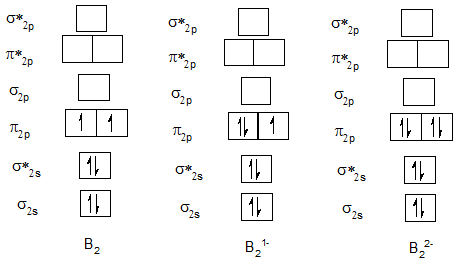
Bond order of C2, C21- and C22-.
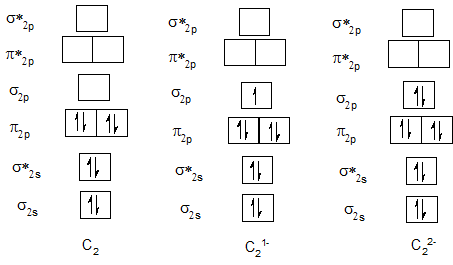
Bond order of N2, N21- and N22-.
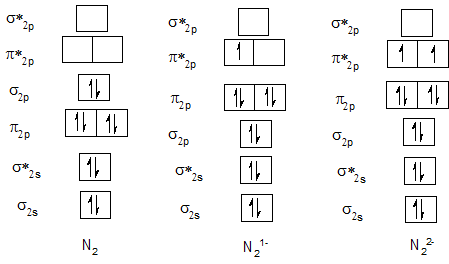
Bond order of O2, O21- and O22-.
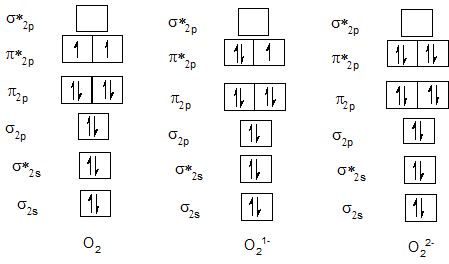
Bond order of F2, F21- and F22-.
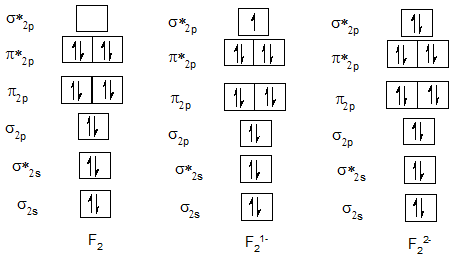
| Neutral diatomic molecule | Bond order of neutral molecule | Molecular anion | Bond order of anion | Molecular anion | Bond order of anion |
| B2 | 1 | B21- | 1.5 | B22- | 2 |
| C2 | 2 | C21- | 2.5 | C22- | 3 |
| N2 | 3 | N21- | 2.5 | N22- | 2 |
| O2 | 2 | O21- | 1.5 | O22- | 1 |
| F2 | 1 | F21- | 0.5 | F22- | 0 |
From the data in the table we can say that bond order of B2 is smaller than B21- and bond order of B21- is smaller than B22-. Therefore bond length of B2 is larger than B21-. Also bond length of B21- is larger than B22-. Similarly bond length of C2 is larger than C21-. Also bond length of C21- is larger than C22-. Therefore the bond lengths of the anions of the homonuclear diatomic molecules formed by B and C have shorter bond lengths than those of the corresponding neutral molecules.
Conclusion:
Bond order is inversely proportional to bond length. From bond order of each molecule and corresponding anion, the bond lengths of the anions of the homonuclear diatomic molecules formed by B and C have shorter bond lengths than those of the corresponding neutral molecules.
Want to see more full solutions like this?
Chapter 5 Solutions
CHEM:ATOM FOC 2E CL (TEXT)
- Beer’s Law is A = εbc, where A is absorbance, ε is the molar absorptivity (which is specific to the compound and wavelength in the measurement), and c is concentration. The absorbance of a 2.31 × 10-5 M solution of a compound is 0.822 at a wavelength of 266 nm in a 1.00-cm cell. Calculate the molar absorptivity at 266 nm.arrow_forwardHow to calculate % of unknown solution using line of best fit y=0.1227x + 0.0292 (y=2.244)arrow_forwardGiven a 1,3-dicarbonyl compound, state the (condensed) formula of the compound obtaineda) if I add hydroxylamine (NH2OH) to give an isooxazole.b) if I add thiosemicarbazide (NH2-CO-NH-NH2) to give an isothiazole.arrow_forward
- Complete the following acid-base reactions and predict the direction of equilibrium for each. Justify your prediction by citing pK values for the acid and conjugate acid in each equilibrium. (a) (b) NHs (c) O₂N NH NH OH H₁PO₁arrow_forward23.34 Show how to convert each starting material into isobutylamine in good yield. ཅ ནད ཀྱི (b) Br OEt (c) (d) (e) (f) Harrow_forwardPlease help me Please use https://app.molview.com/ to draw this. I tried, but I couldn't figure out how to do it.arrow_forward
- Propose a synthesis of 1-butanamine from the following: (a) a chloroalkane of three carbons (b) a chloroalkane of four carbonsarrow_forwardSelect the stronger base from each pair of compounds. (a) H₂CNH₂ or EtzN (b) CI or NH2 NH2 (c) .Q or EtzN (d) or (e) N or (f) H or Harrow_forward4. Provide a clear arrow-pushing mechanism for each of the following reactions. Do not skip proton transfers, do not combine steps, and make sure your arrows are clear enough to be interpreted without ambiguity. a. 2. 1. LDA 3. H3O+ HOarrow_forward
- b. H3C CH3 H3O+ ✓ H OHarrow_forward2. Provide reagents/conditions to accomplish the following syntheses. More than one step is required in some cases. a. CH3arrow_forwardIdentify and provide an explanation that distinguishes a qualitative and quantitative chemical analysis. Provide examples.arrow_forward
 ChemistryChemistryISBN:9781305957404Author:Steven S. Zumdahl, Susan A. Zumdahl, Donald J. DeCostePublisher:Cengage Learning
ChemistryChemistryISBN:9781305957404Author:Steven S. Zumdahl, Susan A. Zumdahl, Donald J. DeCostePublisher:Cengage Learning ChemistryChemistryISBN:9781259911156Author:Raymond Chang Dr., Jason Overby ProfessorPublisher:McGraw-Hill Education
ChemistryChemistryISBN:9781259911156Author:Raymond Chang Dr., Jason Overby ProfessorPublisher:McGraw-Hill Education Principles of Instrumental AnalysisChemistryISBN:9781305577213Author:Douglas A. Skoog, F. James Holler, Stanley R. CrouchPublisher:Cengage Learning
Principles of Instrumental AnalysisChemistryISBN:9781305577213Author:Douglas A. Skoog, F. James Holler, Stanley R. CrouchPublisher:Cengage Learning Organic ChemistryChemistryISBN:9780078021558Author:Janice Gorzynski Smith Dr.Publisher:McGraw-Hill Education
Organic ChemistryChemistryISBN:9780078021558Author:Janice Gorzynski Smith Dr.Publisher:McGraw-Hill Education Chemistry: Principles and ReactionsChemistryISBN:9781305079373Author:William L. Masterton, Cecile N. HurleyPublisher:Cengage Learning
Chemistry: Principles and ReactionsChemistryISBN:9781305079373Author:William L. Masterton, Cecile N. HurleyPublisher:Cengage Learning Elementary Principles of Chemical Processes, Bind...ChemistryISBN:9781118431221Author:Richard M. Felder, Ronald W. Rousseau, Lisa G. BullardPublisher:WILEY
Elementary Principles of Chemical Processes, Bind...ChemistryISBN:9781118431221Author:Richard M. Felder, Ronald W. Rousseau, Lisa G. BullardPublisher:WILEY





